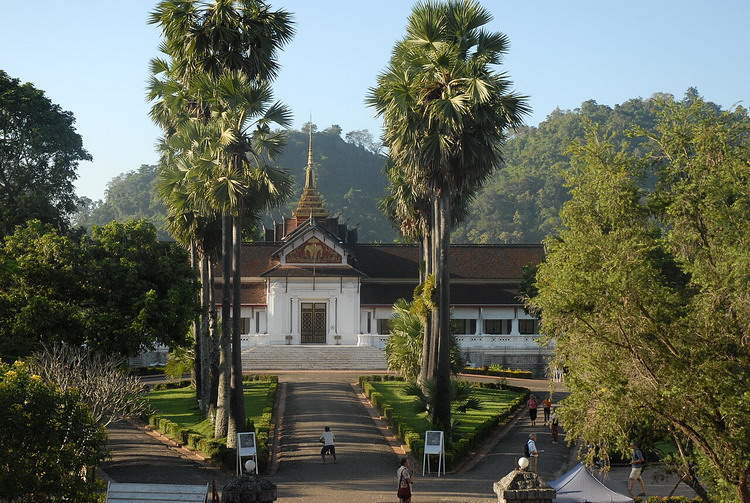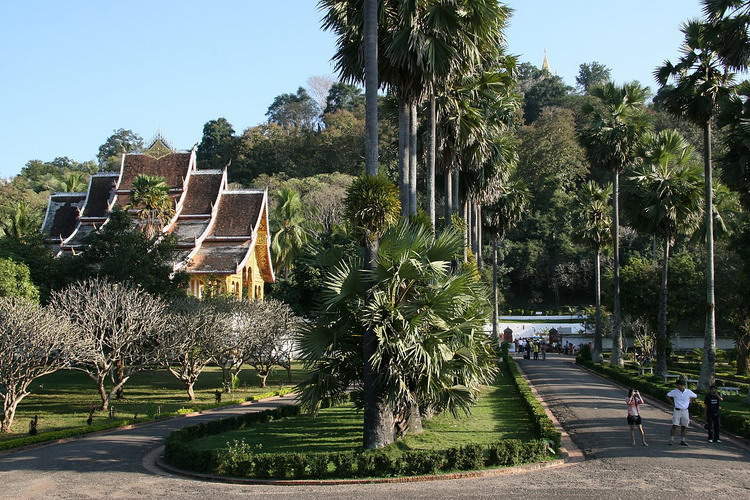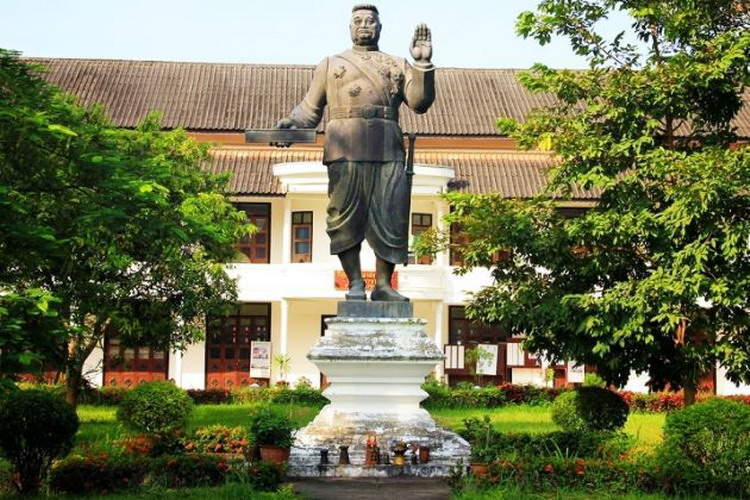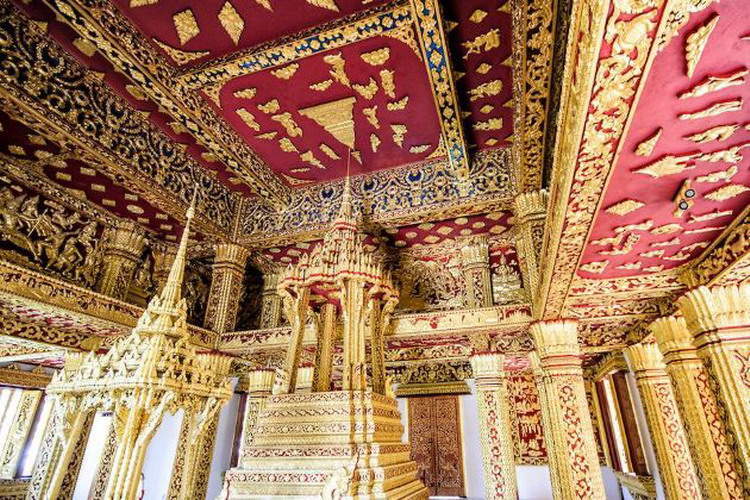Royal Palace Museum
Sitting at the confluence of the Khan River and Mekong River, Luang Prabang is almost like a daydream afar that offers loads of things to awaken your travel sense. No one can deny the charm and attractiveness of this UNESCO-protected gem, demonstrated by an increasing number of Laos tours to this dreaming place. Among all, the Royal Palace Museum in Luang Prabang has proven its world-class comfort and spiritual glamour.
The Royal Palace (official name Haw Kham) in Luang Prabang, Laos, was built in 1904 during the French colonial era for King Sisavang Vong and his family. The site for the palace was chosen so that official visitors to Luang Prabang could disembark from their river voyages directly below the palace and be received there. After the death of King Sisavang Vong, the Crown Prince Savang Vatthana and his family were the last to occupy the grounds. In 1975, the monarchy was overthrown by the communists and the royal family were taken to re-education camps. The palace was then converted into a national museum.
The History of the Royal Palace Museum
Travel a bit further from Luang Prabang’s main boulevards; you will bump into the alluring Royal Palace Museum which is also known as Haw Kham. Actually, there is no better way than pay a visit to this best-known museum in order to gain first-hand experience of typical Laos’s history and long-established tradition.
Dating back to the early 20th century, the Royal Palace Museum becomes home to a huge collection of exhibits that represent the Lane Xang Kingdom’s past and those of the present day. The Museum, therefore, with no doubt, is a perfect place for those being interested in exploring the living condition of Laos’s history. In the past, the Royal Palace Museum used to be the residence of the king and it was beautifully designed with an ideal combination of tasteful scents of traditional, cultural Laos and French Beaux-Arts style.
The Museum experienced a long history. It was in 1975 that the palace was taken over by the communists. At the same time, the royal family was sent to re-education camps. Then, it became a museum and was opened to the public in 1995. A visit to this museum also gives you a chance to explore a number of historical and cultural buildings, including a new exhibition hall and a chapel named Haw Prabang, coupled with a statue of King Sisavangvong.
The Royal Palace Museum Highlights
Once the residence of the royal family, there still exists well-kept royal apartments that would definitely give you an insight into the lifestyle of the royal family. The museum contains a broad collection of ancient religious objects, paintings, weapons, and statues dating back several centuries ago. Along with that, you will have a chance to see the crown jewels of Lao in the Throne Hall. There is a 2,000-year-old Prabang Buddha made from solid gold in the new pavilion.
The Grounds
On the palace grounds, there are other buildings surrounding the palace which includes:
Kitchen/Storage
Royal Barge Shelter
Conference Hall
Haw Pha Bang
Staff Headquarters
There is a lotus pond and two cannons at the entrance of the palace. A statue of King Sisavang Vong is outside the conference hall.
Architecture and furnishings
The architecture of the palace has a mixed of traditional Lao motifs and French Beaux Arts styles. It was laid out in a double-cruciform shape with the entrance on one side of the lower crossbar. Above the entrance is a three-headed elephant sheltered by the sacred white parasol, the symbol of the Lao monarchy. The steps to the entrance are made of Italian marble. There are royal religious objects on display in the large Entrance Hall.
On the right of the entrance is the King’s reception room, where busts of the Luang Phrabang and, later, Lao monarchs are displayed along with two large gilded and lacquered Ramayana screens, crafted by the local artisan Thit Tanh. The walls are covered with murals that depict scenes from traditional Lao lifestyles, painted in 1930 by a French artist, Alix de Fauntereau. Each of the walls is intended to be viewed at a different time of day, depending on the light that enters the windows on one side of the room, which matches the time of day depicted.
In the right front corner room of the palace, which opens to the outside, is a collection of the palace’s most prized art, including the Phra Bang, cast of a gold, silver and bronze alloy. This Buddha stands 83 cm tall and weighs around 50 kg. Legend has it that the statue was made around the 1st century in Sri Lanka and was later gifted by the Khmer king to his son-in-law : King Fa Ngum in 1359.
The Siamese twice took the image to Thailand in 1779 and 1827, but it was returned to Laos by King Mongkut in 1867. There are rumours that the one on display is a copy and the original is stored in Vientiane or Moscow. It is said the real one had gold leaf over the eyes and a hole drilled through one of its ankle. Also in the room are another Buddha, engraved with large elephant tusks, and three beautiful saew mâi khán (embroidered silk screens with religious imagery) that were crafted by the Queen.
On the left of the Entrance Hall, the secretary’s reception room is filled with paintings, silver and china that have been presented to Laos as diplomatic gifts from Myanmar, Cambodia, Thailand, Poland, Hungary, Russia, Japan, Vietnam, China, Nepal, United States, Canada and Australia. These objects are grouped by “socialist” and “capitalist” countries. One exhibit donated by the USA is a piece of Moon rock obtained by an Apollo mission.
The next room to the left was once the Queen’s reception room. Large royal portraits of King Savang Vatthana, Queen Khamphoui and Crown Prince Vong Savang, painted by Russian artist Ilya Glazunov in 1967, are hung on the walls. There are friendship flags from China and Vietnam and replicas of sculpture from the National Museum, New Delhi.
In the far rooms are the royal family’s bedrooms and living quarters. The bedrooms have been preserved as they were in 1975 when the King was forced from the palace. There is a dining hall and a room that contains royal seals and medals.
The Throne Room contains the Crown Jewels of Laos.
Entrance Fee and Opening Hours
The Royal Palace Museum open every day excluding Tuesday from 08:00 to 11:30 am and 13:00 to 16:00. The admission is 30,000 Kip and it’s about $4 per person. Remember, taking photographs inside the Museum is not allowed. Before entering the Museum, cameras and bags can be stored in lockers at the entrance, and dress respectfully.
How to get the Royal Palace Museum
The museum is located on Thanon Sisavangvong in the city center, between the Mekong River and Mount Phousi. You can go on foot, take a tuk-tuk or jumbo ride from the center of town. The price for tuk-tuk between 10,000 Kip (US$1.30) and 15,000 Kip (US$ 2).







